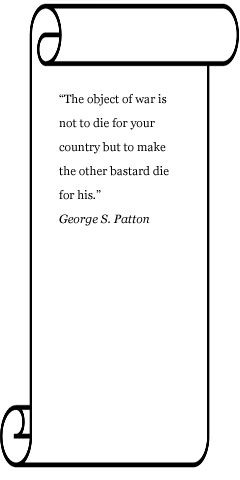Germany’s
Panzerkampfwagen IV
By Mike Bennighof, Ph.D.
September 2012
In an
earlier installment, we looked at Germany’s
early panzers and their appearance in the
Panzer Grenadier series. These
light tanks did not serve for the entire war,
as newer enemy vehicles (in particular, the
Red Army’s T-34 and KV-1) made them
not only obsolete but positively deadly to
their crews. Germany needed a tank that had
at least some chance on the battlefield against
the big Soviet machines.
The feudal nature of the Nazi regime made
it difficult to react quickly to an economic
problem such as producing a new tank. Each
power bloc needed to gets its share of power
and profit, else the project could not advance.
Adolf Hitler’s first order, to reverse-engineer
the T-34 and get it into production as quickly
as possible, did not meet the needs of his
Nazi barons. The vehicle that eventually emerged
from the process, the PzKw V Panther, would
have many fine qualities but entered the lines
years after the troops needed it.
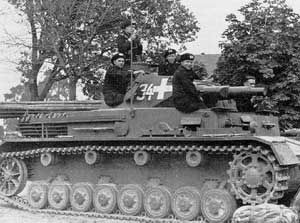
An early-model PzKw IV, probably taken pre-war.
With a new tank design not forthcoming, the
army sought a stopgap measure. Its largest
tank, the PzKw IV, would be re-fitted with
a long-barreled 75mm gun. This weapon could
defeat the T-34’s sloped armor on the
Eastern Front, and in North Africa would penetrate
anything the British could put in the field
except possibly the thickly plated but slow
Matilda.
The Panzerkampfwagen IV had been ordered in
1935 as a support vehicle for the medium tank
companies of the new Panzer regiments. Its
short-barreled 75mm gun would deal with infantry
and “soft” targets, while the
PzKw III served as the main battle tank. However,
slightly more of Krupp’s PzKw IV were
ordered than of Daimler-Benz’s PzKw
III, due to problems with the PzKw III suspension
and Krupp’s greater political weight.
Despite lacking an impressive name, it would
become Germany’s most important tank,
produced in the greatest quantity among German
tanks and the only tank of any nationality
to serve on the front lines for the entire
war.
The first large-scale production model,
the PzKw IV Ausf. C, appeared in 1938. It
saw combat during the campaign in Poland,
and remained in use until 1943 when the last
of them had been lost. 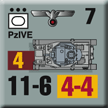
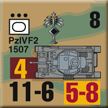

The Ausf. D differed mostly in improved armor protection,
and began production in October 1939, with
229 of them built. Nineteen of them were diverted
to other uses, mostly armored bridge-layers.
Because the D was split over two purchase
orders, it was actually built alongside the
improved model E. Another 223 of the model E were
built.
When that order completed in April 1941,
Krupp received an order for 500 of an improved
type, the PzKw IV Ausf. F. Another 125 machines
were ordered from Vomag and Nibelungenwerke.
The F model had improved armor, but appears
in Panzer Grenadier folded into the
PzKw IV E series.
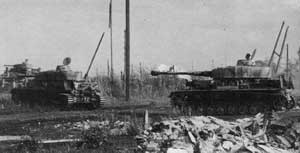
A pair of late-model PzKw IV, with armored
“skirts”
on their turrets to set off hand-held anti-tank
weapons.
The F model, still carrying the short-muzzled
75mm gun, was in production when the Army
issued desperate orders to upgrade the tank’s
firepower as quickly as possible. The Army
had already ordered planning to begin, and
Krupp intended to produce the Ausf. G model
with the bigger gun when the F order completed
in the summer of 1942.
Instead, the last 200 became PzKw F2 models,
with the long 75mm L43 gun and considerably
more anti-tank stopping power. The production
lines halted at all three contractors for
a month in March 1942, while the new tooling
was installed. The first re-armed tanks appeared
late that month, and proved a very satisfying
upgrade to the old vehicle, if not yet a match
for the powerful Soviet tanks.
An experimental model D with a 50mm L60
gun, the same type then being fitted to the
PzKw IIIJ in a similar emergency upgrade,
was constructed in November 1941 but Krupp’s
engineers recommended waiting for the 75mm
gun and the army concurred.
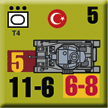
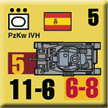
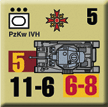
Following models continually improved the
tank’s armor protection. The L/48 gun
introduced with the model G remained the tank’s
main gun until production halted in March,
1945. Orders spiralled ever upward: 1,687
for the model G, 3,774 for the model H, and
1,758 for the model J. The model J represented
a step backwards in one respect: To cut production
time, the turret traverse’s electric
drive gave way to a hand-cranked system.
Even with the short 75mm L24 cannon, the
PzKw IV could destroy enemy tanks using hollow-charge
rounds. These became available in the summer
of 1941 in both Russia and North Africa.
By the end of the war, each panzer division
on paper had one battalion of PzKw IV tanks
and another of Panthers. Several instead had
two of PzKw IV’s, some just one. The
tank could still hold up against the American-made
Shermans and British Cromwells, but had never
been a true match for the T-34 and this became
even more apparent when the T-34/85 entered
the battlefield.
The PzKw IV appears in almost all of the
Panzer Grenadier series games.
And it will continue to show up in many more.
Put the PzKw IV into action! Order Eastern Front right now! |

